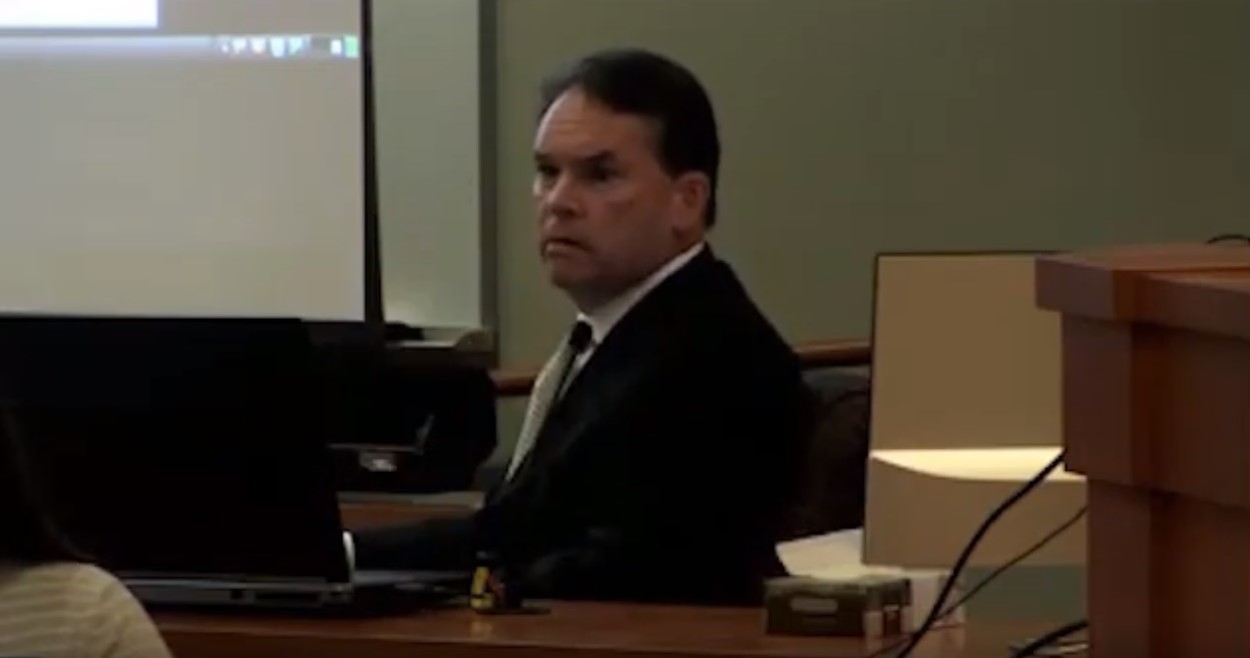

The Expert: Dr. David Owens, testifying for the plaintiff, on why imaging may not reveal milder traumatic brain injuries.

Testifying in a 2019 Georgia premises liability trial, the Georgia based diagnostic and neuroradiologist, Dr. David Owens, explains how traumatic brain injury, or TBI, can exist without radiologic evidence of a brain injury. The plaintiff claimed to suffer a TBI when he was struck in the head by a pipe that fell from a hotel’s rooftop. In addition to challenging liability, the defense questioned the severity of the man’s injury.
The expert begins by showing a slide of brain cells so the jury can envision how this type of injury occurs. Each nerve cell has a very long component called an axon that carries nerve impulses from one nerve to another. When the skull hits something and stops, the momentum of the brain within the skull causes it to smack against the inside of the skull. This sudden deceleration can cause different types of brain injury depending upon the direction and force of its momentum. If it is violent enough, this injury will be manifest by bleeding or bruising of the brain, which can be delineated on a CT scan. However, in some cases the axon can be damaged by tearing at the microscopic level, without causing blood loss that would be picked up on an X-ray like a CT scan. In other cases, shearing will leave the axon itself intact, but tear the tiny blood vessels that supply the nerves. This will cause the nerve to function poorly or even die.
Major traumatic brain injury occurs with a sudden complete deceleration from high speed resulting in significant bleeding into the brain that can be seen on CT or MRI. With minor traumatic brain injury, shearing occurs but it does not show up on either CT or MRI, except in about 10-12% of cases. A CT is a specialized X-ray that circles the body measuring densities of the parts that are examined. It is especially good for significant bleeding or tumors. However, if the CT is negative, that does not completely rule out the possibility of a TBI, since the shearing injury may not show up.
If a patient has bleeding in the brain that shows up on the CT or MRI, admission to the neuro ICU and neurosurgery consultation is imperative. If imaging fails to demonstrate intracranial hemorrhage, the treating physician can make decisions without worrying that there will be a major event causing the patient to stop breathing within the next 24 hours. If there is nothing else demanding hospital admission, then the patient with a negative radiologic exam can be discharged home. Owens indicates that this subset of patients, though not diagnosed with concussion at the time, can later develop significant symptoms. “I see that all the time,” he states
The doctor says that the MRI is more powerful than the CT and uses the force of magnetism to decipher different densities within the body, and that information is used to see the internal organs without using X-ray radiation. The MR scan can look at things in greater detail on magnification, than CT, but it cannot decipher injury at a microscopic level. Meanwhile, the CT is used if bleeding is suspected or needs to be ruled out. If none is seen, but the real pathology is not apparent, then MRI scanning is indicated. This will usually reveal the problem, but again, except in 10-12% of cases, it does not show up on either exam with minor traumatic brain injury.
The doctor’s testimony was crucial, as the jury awarded $5.5 million.
Gary Gansar, MD, is residency-trained in general surgery. He served as Chief of Surgery and Staff at Elmwood Medical Center and on the Medical Executive Committee at Touro Infirmary and Mercy Hospital in New Orleans, LA. Dr. Gansar was Board Certified in general surgery while in active practice. He joined AMFS in 2015 as a Physician Medical Director.
The medical expert witness partner for attorneys serious about building a winning case
AMFS is your trusted source for highly-qualified medical expert witnesses. After pioneering the field nearly three decades ago, we’re continuing to redefine medical expert witness services by providing value far beyond a referral alone.
Our Physician Medical Directors know what it takes to build a strong case. Our medical expert witnesses leave no doubt. And our case managers streamline billing and logistics every step of the way, letting you focus on what you do best: constructing your winning case. Explore why AMFS clients expect more from their medical expert witnesses—and get it.
